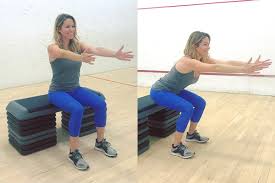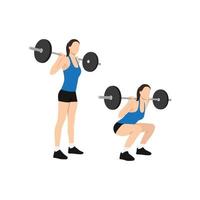HIP HINGE EXERCISES:
Using the concept of the squat in dynamic and safe ways.
Keep the back of your head in line with your spine at all times
when hinging. The torso and head unite as one.
With the Hip Hinge, there is a world of difference between sitting and standing. It is far easier to find the proper alignment seated. The seated hinge is an extremely relaxing position for the lower back especially. Clarity of isolated joint movement is so simple to achieve. But a willingness to sensitively listen to your body is needed to release tension and allow real freedom of movement in the hip joint.
As soon as you stand, alignment is more complex and muscularity is emphasized instead of release. It is interesting that such similar postures require such different efforts, both desirable.
Each are extremely valuable for all body types and ages. Professional dancers, coaches, fitness experts, weightlifters will all benefit from the released hinge almost as much as those older do. For seniors, the seated hinge series is very effective at reducing lower back pain and tension, making walking far safer and easier. The squat in turn is a fundamental technique for increasing lower body stability and strength that is helpful to practice for anyone. It is crucial though to use proper technique.
Each are extremely valuable for all body types and ages. Professional dancers, coaches, fitness experts, weightlifters will all benefit from the released hinge almost as much as those older do. For seniors, the seated hinge series is very effective at reducing lower back pain and tension, making walking far safer and easier. The squat in turn is a fundamental technique for increasing lower body stability and strength that is helpful to practice for anyone. It is crucial though to use proper technique.
SEATED EXERCISE
The seated hinge: beneficial for everyone, especially seniors and anyone with lower back issues.
|
- Maneuver your torso as if it is a plank, moving as one piece, including the head.
- Rest with your torso tilted forward. Place your elbows or hands on your knees. Keep the back of your head in line with your spine and relax your lower back completely.
An effective companion technique: Releasing the quadriceps increases the depth of hip joint release.
Seated quadriceps thigh release: While practicing tilting of the torso forward and back, it is quite wonderful to use your hands to massage the tops of the thighs. This helps to release the muscles so that they can be more effectively stretched, which in turn improves how much the lower back can relax.
- Tilt yourself forward and back.
- Use your torso body weight to apply gentle pressure.
- Press downward onto the thighs with your hands in sequence, first above your knees, then moving toward the hips, pressing down every few inches upon the breadth of the quadriceps. Reverse directions. The weight of your torso rocking forward and back enhances this static massage.
- Finally place the heel of both hands on the crease in the hip joint and press firmly downward, stretching the torso up and away, to gently open the joint.
- Starting at the top of the thighs, take the heels of the hands and press them down and out toward the knee, "ironing" out any tension in the quad muscles.
- Pull the knee up and into your chest to stretch the thigh (and knee as well).
As the hip releases, the deep lower back can as well.
Seated sacral release:
- As you sit tilted forward, allow your torso to tilt farther forward til you pelvis is between your legs. Keep your hands on your knees.
- Keep your head in line with your spine.
- Your entire torso plus the tops of your thighs will ultimately form a table.
- Concentrate on releasing across the entire lower back including the sacroiliac joints (the joints which connect the pelvis to the sacrum) as well as the sacrum itself.
- Push into your hands to rise.
- For an added stretch, after forming the "table" with your pelvis and thighs, place both hands flat on the floor.
Senior squat and variations:
The basic senior squat:
- Sit forward in your chair as above with your lower back in an upright position with your knees over your feet, legs apart.
- Place your hands on your knees.
- Tilt yourself forward. Maintain a plank-like torso throughout.
- Place your weight onto your hands and push down to lift your rear end off the chair.
- This is the standing squat position.
- Unfold into standing.
Seated hinge stretches:
The seated hinge position is so beneficial for the body that stretching from that position is easy and very effective at releasing tension in the deep lower spine muscles and joints. The positions can easily be adjusted to reach particularly tight spots in the lower back, making these wonderful exercises for anyone experiencing lower spine inflammation and pain.
- Single leg hinge: Sitting upright from the hinge position, turn your plank-like torso toward your right thigh and fold over it, keeping the torso straight. Place your hands on top of your thigh so that your weight pours down through your hands and into your quadriceps, releasing tension. Place your forearm across the top of the leg, crossing the other arm over to rest with your torso still straight. Focus on releasing lower back tightness on the opposite side of your lower back.
- Lateral torso twist and reach: Sit tilted forward with your elbows on your knees. Keep your forearm on top of your thigh. Place your other hand on the other thigh. Open the chest out to the side. This stretches the muscles around the front of the other hip joint.
- Diagonal reach across: Sit tilted forward with your elbows on your knees. Bring one shoulder forward. Take that arm and reach out and across to the other side of the body, stretching the back of the hip.
STANDING EXERCISE
The standing squat position: an essential element in weightlifting.

- Stand with your feet apart, knees over your feet, toes moderately turned out.
- Bend your knees and drive your hips backward.
- Bend so that your torso is tilted forward and your rear end sticks out to the back.
- Keep your spine straight throughout.
If you draw a vertical line through the center, the top part of the body is as far forward as the bottom part of the body is backward.
Standing squat exercises:
Check your alignment: Squat exercises can be aggressive for the body. It is essential to get yourself aligned correctly first. Look at yourself sideways in a mirror to check to make sure that the torso is straight and the lower back is not hyperextended but simply in line with the spine. Make certain your feet are in a solid stance and that your knees do not experience stress when bent. Check in a mirror to make sure your knees are over your feet.
There are many, many squat exercises. You could write a book just about the squat and how to do it properly. This is a very basic sampling:
Simple standing squats: Bend and straighten in and out of the squat position repeatedly. As you straighten, drive your feet into the ground. Arms can be in different positions: across the chest, reaching straight out, on the hips. You can also place your hands on top of your legs and massage the thighs as you descend into the squat for a lovely quad release at the same time, similar to the seated quad release described above.
Weighted Squats:
Simple standing squats: Bend and straighten in and out of the squat position repeatedly. As you straighten, drive your feet into the ground. Arms can be in different positions: across the chest, reaching straight out, on the hips. You can also place your hands on top of your legs and massage the thighs as you descend into the squat for a lovely quad release at the same time, similar to the seated quad release described above.
Weighted Squats:
Picking things up off the floor using the squat:
|
This is the most stable method of all for picking anything up off the floor. The only joints which are used are the hip and knee joints. The spine remains fixed throughout. Always paramount is to first face the object head on. Use your core muscles to help you lift. Inhaling as you lift is an effective way to use your breath. It is also essential to focus your eyes to avoid dizziness.
|
Published July 17, 2023.





